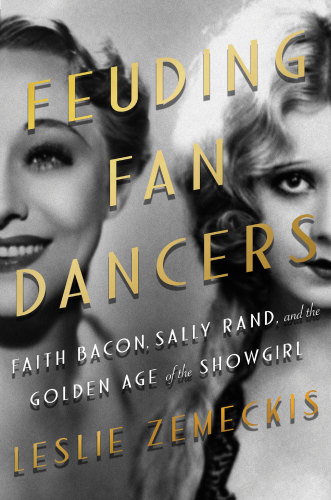
Feuding Fan Dancers
Faith Bacon, Sally Rand, and the Golden Age of the Showgirl
فرمت کتاب
ebook
تاریخ انتشار
2018
نویسنده
Leslie Zemeckisنویسنده
Leslie Zemeckisناشر
Catapultناشر
Catapultشابک
9781640090606
- اطلاعات
- نقد و بررسی
- دیدگاه کاربران
نقد و بررسی

July 15, 2018
In the 1920s and '30s, showgirls worked hard, hustled, and competed in a brutal entertainment business.Actress, filmmaker, and historian of burlesque Zemeckis (Goddess of Love Incarnate: The Life of Striptease Artist Lili St. Cyr, 2015, etc.) focuses on fan dancers Faith Bacon (1910-1956) and Sally Rand (1904-1979) and reveals their struggles, dreams, and glittery triumphs. Frances Yvonne Bacon was groomed and manipulated by an ambitious stage mother who pretended to be her sister and sometimes performed in the same shows. In her teens, Yvonne, who later changed her name to Faith, was one among many other young women "sought, hired, prized, and praised for the perfection of their figures." Scantily clothed, resplendent in jewels and feathers, they paraded in "respectable, naughty" extravaganzas mounted by impresarios such as Florenz Ziegfeld or his competitor Earl Carroll, an egotistical "Hugh Hefneresque" figure. Broadway, the author writes, "was assaulted with ruthless promoters of beauty and flesh trying to one up the other." The women they hired, though, were proud of their bodies and eager for admiration. At the age of 19, working for Carroll, Faith was "at her most luminous," with "blue-grey eyes, winsome and doe-eyed with a slim alabaster figure." In one of Carroll's productions, she had an idea: to get around the law, which forbade a nude performer from moving on stage, she would dance covered with fans, then stop, raise them above her head, and reveal herself naked. The fan dance became her signature--until Hattie Helen Beck, aka Billie Beck, aka Sally Rand, performed it "to thunderous applause" at the 1933 Chicago World's Fair. Unlike Faith, who was emotionally fragile, Sally was resilient, enterprising, and unsinkable. Still performing at the age of 60, she remarked proudly, "what in heaven's name is strange about a grandmother dancing nude?" Faith sued Sally, claiming ownership of the fan dance, but Sally prevailed. Widely acclaimed, she performed for some 7 million people throughout the world. Faith, addicted to barbiturates and destitute, killed herself.A briskly told story of two women questing for fame.
COPYRIGHT(2018) Kirkus Reviews, ALL RIGHTS RESERVED.

August 1, 2018
In a world where a woman's only currency is her beauty, her value was fleeting--unless she had the inner strength and courage to warp it to her will. In this title, Zemeckis (Behind the Burly Q) explores the lives of Faith Bacon (1910-56) and Sally Rand (1904-79), two old-school showgirls who danced their way from Hollywood to Broadway and every state in between, starting in the 1920s. Of the two, Rand is most remembered while Bacon has been largely forgotten. Both were fan dancers, flouting modesty laws by coyly hiding their gorgeous bodies behind huge ostrich feather fans. Bacon may have originated the dance on Broadway in Earl Carroll's Vanities, but Rand took it, adapted it, and ran with it. Their paths often ran parallel until they finally diverged when Bacon committed suicide. VERDICT Zemeckis brilliantly captures an era long vanished, filled with stage mothers, slimy producers, devious cons, and classic mobsters that will fascinate fans of the showgirl era, theater history, and early to mid-20th-century showbiz.--Teri Shiel, Univ. of Connecticut Health Ctr. Lib., Farmington
Copyright 2018 Library Journal, LLC Used with permission.

August 27, 2018
In this love letter to performers of silent films and the vaudeville circuit, Zemeckis (Goddess of Love Incarnate) takes a deep dive into the hardscrabble lives of two of the most famous performers of the 1930s: Faith Bacon and Sally Rand. Born Harriet Beck in 1904 Missouri, Rand performed for years as a nude and seminude dancer in venues throughout the country. But it wasn’t until a performance at the 1933 Chicago World’s Fair that Rand, assisted by a pair of pink, seven-foot ostrich feathers, gained wider popularity. The next year, Zemeckis writes, she, along with actress Mae West, “were the record earners amongst women entertainers.” Rand often competed with Bacon (born in Los Angeles in 1910), who at the age of 13 was posing nude as an artist’s model. Bacon’s ease with her body led her, like Rand, to the stage, where she became a Ziegfeld Girl. Rand, a skilled self-promoter, was able to parlay the fan dance into a six-decade-long career while Bacon, who originated the concept, was often in Rand’s shadow. Their competition became so intense that Bacon filed a lawsuit against Rand over artistic theft. Zemeckis brings to vivid life these two performers in an exciting era.

September 15, 2018
Think today's show business environment is a rough-and-tumble world? It's a cakewalk compared to the unrelenting competitiveness, grueling physicality, and legal persecution that plagued showgirls of the 1930s. None were more revered or reviled than those who titillated their audiences by performing nude with the aid of strategically placed props. Personified by Sally Rand and Faith Bacon, fan dancers were the ultimate sybarites. Proud of their bodies, determined to find show business success, Rand and Bacon seesawed from abject poverty to untold riches. Rand may have been brash and bawdy, Bacon ethereal and elegant, but both were equally tough competitors, hardened by their feud to claim the title of fan dance originator and driven by an insatiable desire for accolades and respect. Zemeckis (Goddess of Love Incarnate?, 2015) is a tenacious historian of the lost days of burlesque. While this narrative purports to chronicle the golden days of the fan dance, it more dramatically reveals the tarnish and disgrace suffered by two of its most notorious practitioners.(Reprinted with permission of Booklist, copyright 2018, American Library Association.)




دیدگاه کاربران